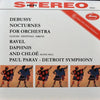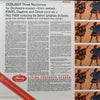



Debussy – Nocturnes For Orchestra & Ravel - Daphnis And Chloë, Suite No.2 - Paul Paray, Detroit Symphony
Rarity - Sealed
Claude Debussy – Nocturnes For Orchestra
Maurice Ravel - Daphnis And Chloë, Suite No.2
Detroit Symphony Orchestra
Conductor - Paul Paray
Chorus – Wayne State University Women's Glee Club (A1-3)
Chorus Master – Malcolm Johns (A1-3)
1 LP, standard sleeve
Original analog Master tape : YES
Heavy Press : 180g
Record color : black
Speed : 33 RPM
Size : 12'’
Stereo
Studio
Record Press : Pallas
Label : Speakers Corner
Original Label : Mercury Living Presence
Recorded at Cass Technical High School Auditorium, Detroit & Orchestra Hall, Detroit
Engineered by Robert Eberenz
Produced by Wilma Cozart
Co-producer – Harold Lawrence
Transferred by George Piros
Illustration by Léon Bakst
Sleeve Notes by John Scrymgeour
Originally released in 1962
Reissued in October 2006
Tracks :
Side A : Nocturnes For Orchestra
- Nuages (Clouds)
- Fêtes (Festivals)
- Sirènes (Sirens)
Side B : Daphnis Et Chloé, Suite No. 2
- Lever Du Jour
- Pantomime
- Danse Générale
Reviews:
Working with the 90-odd members of a full symphony orchestra, though not without its complications, has become reasonably easy for the members of the Mercury recording staff. In the third Debussy Nocturne, however, a full female chorus is added to the texture, not as a soloistic group but rather as another instrumental color. For the purposes of recording, Debussy's direction in the score to use sixteen singers was disregarded; somewhat more than twice that number are actually heard. The chorus was ranged behind the last rows of the orchestra on the stage of Cass High School auditorium, pretty much filling up all available space. After this particular section was finished, the chorus departed, and the orchestra was reseated with a little more room.
Like all Living Presence stereophonic recordings, these two works were recorded with three extremely sensitive omnidirectional microphones which were hung in front of the orchestra at the beginning of the session, tested for balance, and then never moved. Likewise, the volume controls on the recording machines were adjusted by means of level checks at the start, and then they were not moved throughout the session. In this way Mercury recordings preserve the entire dynamic gamut of a real performance, and the listener hears the music just as he would at a live concert ... better, in fact, because the microphones are hung in the focal point of the auditorium, an optimum position where no seat could ever be.
Wilma Cozart was the recording director for the session, Harold Lawrence was the musical director, and Robert Eberenz was the engineer. George Piros made the transfer from tape to disc.
Ratings :
Discogs :

